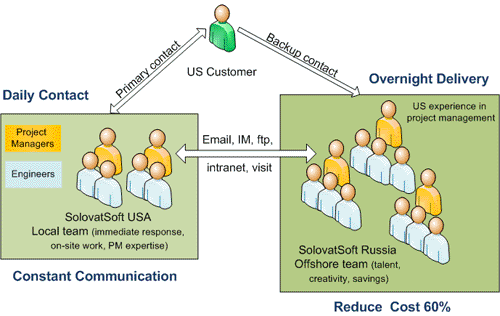Documentation
Useful Links
Outsourcing Consulting News
Offshore Product Development and Maintenance Framework
SoloSoft on site/offshore delivery model leverages the advantages of US presence with offshore skillful engineers to create the cost savings in 50-70%. Typically in our work we propose to use 3 common approaches:

1. Project-Based Outsourcing
| Phase | Activities | Deliverables |
|---|---|---|
| Analysis/Requirements |
» Gather requirements » Scope the project » Describe the old architecture » Identify critical issues |
» Project Proposal » Requirements Document » Project Plan » System Architecture |
| Design Documents creation |
» Develop System Design Schema » Create detailed project plan |
» Design Document » Hardware and system architecture » QA Plan |
| Development/Unit testing |
» Modules coding » Unit Testing » System in overall development » Test case development |
» Test Plan » Issue Tracking Log » Code Walkthrough Review » System Test Cases |
| System testing/Integration |
» Test cases running » Bug Fixing » Change request review » Update test cases » Update Design Document |
» Test Plan » Test Cases » Test Log sheet » Approved Change Requests » Updated Design Document |
| Acceptance/Release to Production |
» Verify Acceptance criteria » Bug Fixing » Change Request review » User Training » Development of User Manuals |
» Sign Off on Acceptance » List of QA bugs » User Manuals » Installation/Release Notes |
2. Time and Material Outsourcing
It's one of the approaches SoloSoft can propose to use because there may be some additional change requests made in the middle of the project that can result in the budget overrun and project delay. Also this "Time and Material" approach is the best when our potential client want to start development righ away but has not created a whole suite of project requirements documentation.
Typically our US Project managers spend more time managing the contract to ensure our customer is getting the appropriate value for the time they are paying.
3. The Dedicated Development Team Methodology
Our well-defined, 6-step methodology has been evolved based on our development experience of numerous Offshore projects. This approach applies offshore and onsite implementations.
-
Step 1. Project Team Creation
- Scope Agreement sign off
- Need to identify key team members for project
-
Step 2. Onsite to Offshore Knowledge Transition
The main goal for this phase is to understand the client requirements, business processes, company standards, the specific systems IT environment as well as the approach that will be used. It's a huge learning curve.
-
Step 3. Offshore Process Definition
Perform customization of the methodology for the client specific requirements.
-
Step 4. Offshore Simulation
- Simulate client IT environment at offshore development Center
- Review and confirm the Service Level Agreements
- Build the Offshore Infrastructure (IT, software and physical)
- Set up the offshore team
- Metric-defined training of the Offshore Development team
-
Step 5. Offshore Project Execution
Start executing project according to the project plan for the first 6 month period.
-
Step 6. Review the project deliverables and identify the weak areas of the implementation
- Implement the feedback
- Have the first year Service Agreement review
Our proven offshore software development process has enabled our clients to dramatically cut software development life cycle costs up to 65%. These costs savings are enabled by: